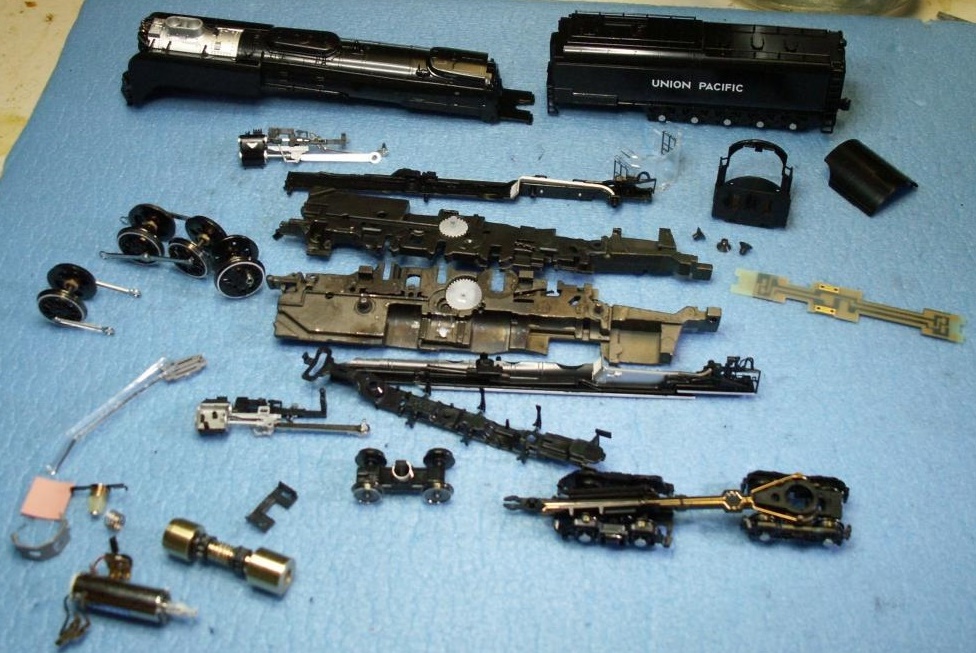

Introduced: 2014 (DCC-Ready passenger version), 2015 (Kobo Custom DCC-Equipped passenger version) and 2016 (Freight version)
These gorgeous looking and fine running steamers were released in concert with an entire modern-day Union Pacific business/excursion passenger train set. And given their outstanding looks and sublime performance (not to mention the fact that the UP's grand old #844 is one of the most iconic steam locomotives still in operation today), I suspect that these models will find homes on many a non-UP model railroad.
As noted above, limited edition decoder-equipped versions of these models were sold by Kato's "Kobo Custom" division shortly after the initial DCC-Ready release (available with either a TCS decoder or an ESU Loksound decoder and speaker). Also as noted above, "freight" versions were released in 2016. Apart from the paint scheme (matte black body, graphite smokebox and black-rimmed wheels), these are identical to the passenger versions -
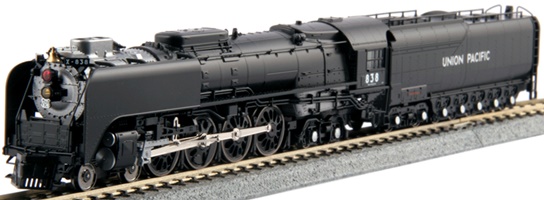
Kobo Customs also released a limited run of custom-weathered FEF's in 2019 -
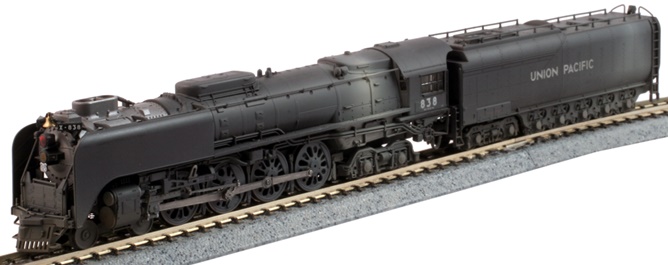
Internally, the model is the very definition of "state of the art" -

The locomotive chassis is all-metal, split-frame and nicely hefty. The five-pole motor is coreless (a first for Kato).The brass driveshaft/worm assembly includes a pair of flywheels. Directional LED lighting is provided by a PC board mounted on top of the engine chassis. A plastic extension off of the lightboard transfers light up to the headlight housing (note that the red MARS light mounted over the headlight is non-operational). As delivered, there is no pilot coupler. However, a replacement pilot with a fixed/rigid knuckle coupler is supplied in the box should you wish to set your FEF up for double-heading.
The lightboard is designed such that it can be popped out in favor of a DCC decoder (TCS K6D4, Digitrax DN163K4A, etc). And at least as of this initial writing, Kato also sells these models with pre-installed TCS decoders.
Six of the eight drivers provide pickup (with the third pair from the front being equipped with traction tires). The pilot and trailing trucks are electrically neutral. Only the traction-tire equipped driver pair is geared (with all the rest of the drivers being turned by the running gear). Apart from the brass worm, all gearing is plastic. Wheels are blackened and low-profile, so no problems on Code-55 rails.

A really innovative new feature on this model is its stabilizer/equalizer mechanism over the front two axles. This serves to keep all four of the front drivers on the track for maximum traction and pickup. Similarly, the rear driverset is stabilized by coiled suspension springs (the driven axle is fixed and rigid).
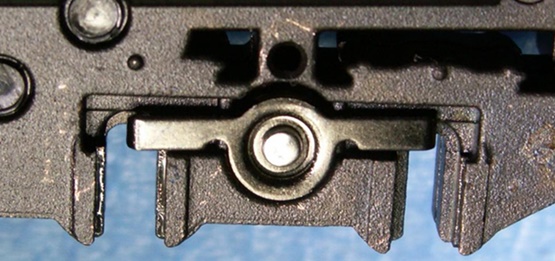
The five-axle "centipede" truck on the tender is rather cleverly broken up into two separate trucks (presumably to allow for operations on sharper curves). Eight of the fourteen tender wheels provide pickup. The forward two-axle truck collects current via low-friction axle cups, whereas the rear two-axle truck employs inside-bearing axle pickup (similar in design to the pickup on Kato's Amfleet passenger cars). Current is transferred from the tender to the engine chassis by way of a pair of stiff wires inside the plastic drawbar. An automatic/magnetic knuckle coupler is part of the rear truck assembly -

With all of the electronics residing up inside the engine, there's not much going on inside the tender. Unfortunately, this means no backup light (although a lens is provided in the shell, so one could conceivably wire up some sort of homebrew light fairly easily) -

Performance is, in a word, flawless. The model runs super smooth and whisper quiet at all throttle levels. Pickup is perfect, allowing for amazing slow-speed creep. OK, yes, the top-end speed is excessive, but that just seems to be a Kato tradition at this point. Pulling power is simply off the charts (I have no idea what the actual upper limit might be, but I've seen youtube video of one pulling 40+ passenger cars). I'm not exactly sure what the minimum radius is for curves, but it's definitely not the 11" minimum that Kato advertises (mine consistantly derails on 11"-radius curves or sharper). I'd say that 13" is probably a more realistic minimum. Overall though, these are flat out gorgeous looking models that perform every bit as good as they look. Definitely one of the all-time greats of N scale steam, and certainly another homerun for the folks at Kato.
Prototype information -
The Union Pacific FEF (Four Eight Four) is easily one of the most recognizable US steam prototypes still in operation today. The FEF-3 series of steam locomotives was delivered in 1944 and were the last (and some of the largest) steam locomotives used by the Union Pacific. Operated solely by the Union Pacific, the FEF's (often referred to as "Northerns" in deference to the Northern Pacific who originated the wheel arrangement) were intended primarily for passenger service. However, given the UP's large fleet of available passenger diesels, the FEF's were occasionally put to work in fast freight service as well.
Today, FEF-3 #844 (variously known as #8444 to avoid numbering conflicts with diesel locomotives) is one of the UP's oldest operating locomotives and can be found pulling publicity/excursion trains. Accompanying the "living legend" FEF-3 is always at least one of a pair of Union Pacific water tenders, carrying spare water for the steam engine (water filling stations being a rarity in the diesel era). These unique re-built cars have seen service as both steam and gas-turbine electric fuel tenders before finally settling into their current forms as part of UP's steam heritage fleet where they operate as separate (but always-present) cars.
Model Features -
The Kato N Scale FEF-3 follows in the footsteps of its Southern Pacific 4-8-4 cousin, refining the basic concept of a high-power, flexible steam locomotive which is easily upgradable to DCC by coupling a special, isolated coreless motor drive system with heavy duty flywheels and a flexible cross-braced suspension system that gives the locomotive a high torque, high traction grip that ensures constant and consistent pressure spread across the primary drivers. Another benefit of the coreless motor system is that the locomotive will have an extremely low starting voltage, giving the locomotive slow creeping speeds that will allow modelers to appreciate the complex arrangement of moving side rods that make steam operation so exciting. Other features, such as the locomotive's unique "Centipede" style tender being fitted with special articulation mechanisms that appear seamless when observed but will bend and flex to allow the locomotive to navigate tighter corners than should otherwise be possible!
The water tenders are an all-new design and sold as a two-pack for modelers to supplement their FEF-3 or other UP steam locomotives. Just like the prototype models, the two tenders are not identical, having (in addition to one car having an externally mounted American Flag plate) different weld mark details, ensuring that their unique spirit is preserved when translated into model form.
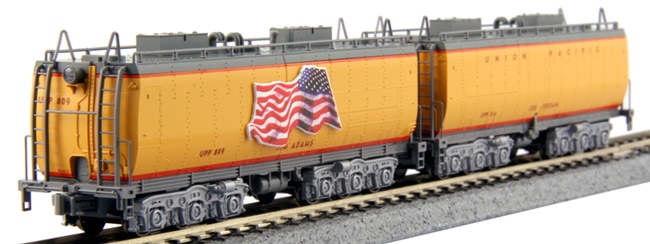
- Semi-modern appearance is appropriate for modern layouts behind UP Excursion trains as well as historical layouts operating freight and UP passenger services
- New coreless motor design with dual brass flywheels for silky-smooth performance at all speeds, even slow crawls
- Special cross-braced shock absorbers equalize the pressure on the locomotive drivers to maximize traction
- Illuminated headlight and locomotive numberboards. The FEF tender does not have operational lights
- DCC friendly design, allowing for easy drop-in installation of DCC. This locomotive is also available with DCC pre-installed from Kato USA!
- Water tenders can be upgraded with an optional light board to illuminate marker lights in either direction (sold separately)
- A separate "Flag" plate is prototypically applied to the Jim Adams water tender
- 11" (282 mm) minimum turning radius on ground level track, 15" (381 mm) minimum turning radius on viaduct track
- All detail parts installed
Trivia - For those interested in running their FEF's with pre-rebuild water tenders, James Norris (JamesTrainParts) sells them through his Shapeways store -

Scaletrains.com makes similar tenders as well -
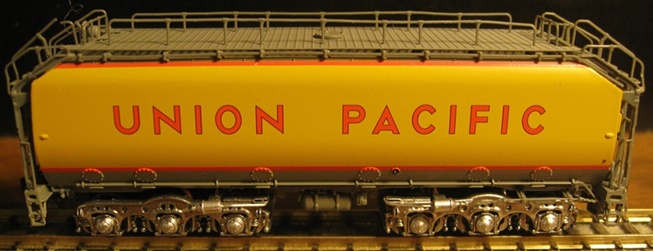
To remove the locomotive shell, first remove the cab (it simply clips in place). Once the cab is out of the way you will see the screw that holds the shell in place. Remove that and that shell should lift right off.
Grade: A
Unless your name is Victor Miranda, I would not recommend treating your brand new FEF like this -
